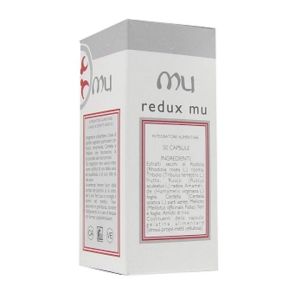Ship in Europe, Find out rates!
Redux mu supplement 50 capsules

- box Delivery in Italy in 24/48 and free returns
- star3.000+ positive reviews
- dropboxOver 60,000 products in the catalog
CELLULITE - INCREASE IN DIURESIS CIRCULATION
It is the optimal phytocomplex for the dietary integration of overweight subjects. Associated with proper nutrition and moderate exercise, can it? facilitate weight loss, improving mood and the unpleasant sensation of "nervous hunger"; can he? promote the selective loss of fat mass in favor of muscle mass, the reduction of cellulite and water retention, improve tone? connective tissue and vascular conditions.
Rhodiola rosea: Yeah? for centuries known and used for its countless properties? beneficial, has Rhodiola rosea seen growing in popularity in recent years? also in western countries thanks above all to its characteristics as a mood modulator, anti depressant and adjuvant in the control of body weight. Its multiple applications have deservedly given it the name of "golden root".
Rhodiola stimulates the action of lipases, enzymes capable of accelerating lipolysis, favoring their metabobolization. It increases the synthesis of ATP and Creatin phosphate in the muscles and, in association with constant and moderate physical exercise, promotes the development of muscle mass, at the expense of fat. This root, thanks to its action on mood, can? help to calm the attacks of nervous hunger which, very often, undermine the success of a controlled diet. Can the glycosides contained in the root increase dopamine levels, a substance capable of transmitting a satiety signal to the CNS?
Rhodiola produces an increase in plasma concentrations of beta-endorphins by preventing stress-related hormonal changes. Tribulus terrestris: Perennial shrub, it grows spontaneously throughout India and in some areas of Africa. It has been used since time immemorial in the Asian herbal tradition, in particular Ayurvedic. The property? tonic-energizing, anabolic, activity stimulants? sexual are due to the presence of steroid saponins; However, recent studies seem to confirm that the action of tribulus, in the recommended doses, maintains the physiological hormonal levels of LH and FSH, without causing overproduction; Tribulus terrestris would therefore behave as a rebalancing of the hormonal balance.
Ruscus aculeatus: Numerous studies have shown the anti-edematous effects of Ruscus extracts, as well as? their effectiveness in the treatment of chronic venous insufficiency, due to an improvement in contractility? venous smooth muscle by stimulating the postsynaptic alpha receptors of myocytes and by increasing the release of noradrenaline from the postsynaptic vesicles; do ruscogenins have anti-edematous and anti-inflammatory effects due to the reduction of permeability? capillary, also inhibit the activity? elastase which hydrolyzes the constituents of the extracellular matrix (elastin, collagen, proteoglycans), as well as? the adherent proteins of the endothelial membranes (fibronectin and others).
Hamamelis virginiana: Amamethyline, gallotannin, in synergy with the other tannins present, have a vasoconstrictive, decongestant and angiotonic action on peripheral circulation and capillaries; the anti-inflammatory action is expressed through the stabilization of the membranes of the vascular cells and the inactivation of lytic enzymes released by the inflammatory process.
Hydrocotyl asiatica: Centella shows a particular trophism for the connective tissue by mainly stimulating the synthesis of glycosaminoglycans, fundamental components of the amorphous matrix of the connective tissue and to a lesser extent, the synthesis of the fibrillar components (collagen and elastin). His activity? it manifests itself with two main therapeutic actions: vasoprotective and trophic-healing. Clinical trials have demonstrated the efficacy of the triterpene fraction of centella in the treatment of cellulite, especially the edematous form of the lower limbs. Melilotus officinalis: The main effect of Sweet Clover is? on lymphatic drainage and owes this property to it? to coumarin whose mechanism of action is? now amply demonstrated. It is a molecule extracted from different plants of the genus Melilotus, able to act on all liquids with a high colloid-osmotic component that form protein edema, with a hydrolytic-enzymatic cleavage mechanism of all the proteins stored in the perivasal interstitium . Does it particularly have the capacity? to accelerate lymphatic drainage, to promote the reabsorption of proteins from the interstitium, to increase the tone of the muscles of the lymphatic and venous vessels.
These properties? have a significant effect on lymphatic and venous edema. The Melilotus officinalis, therefore, rich in coumarin, for its direct action on contractility? of the smooth muscle of the lymphatic vessels and stimulation of the tissue proteolytic function operated by the macrophages, carries out a marked activity? anti-edema.
| Destination | Cost | Detail |
|---|---|---|
| Italy | €5,90* | 24/72H |
| Austria, France, Germany, Slovenia | € 13* | 3 days |
| Belgium, Luxembourg, Portugal, Netherlands, Spain | € 14* | 4 days |
| Bulgary, Cechia, Hungary, Poland, Romania, Slovakia | € 19* | 5 days |
| Denmark, Estonia, Finland, Ireland, Lithuania, Latvia ,Sweden | € 22* | 5 days |
| United Kingdom, Switzerland, Greece, Malta/td> | € 30* | 7 days |
| Canada | € 40 | 7 Days |
European shipments with express courier: FedEx, MBE, DHL
*For the shipment outside band B ther's an extra cost of 22€ *For the shipment outside band C ther's an extra cost of 30€ Delivery Times exclude Saturday and Holidays
For Islands and Areas of difficult Accessibility the shipments are made in 72 hours and the cost will be increased by 15€

